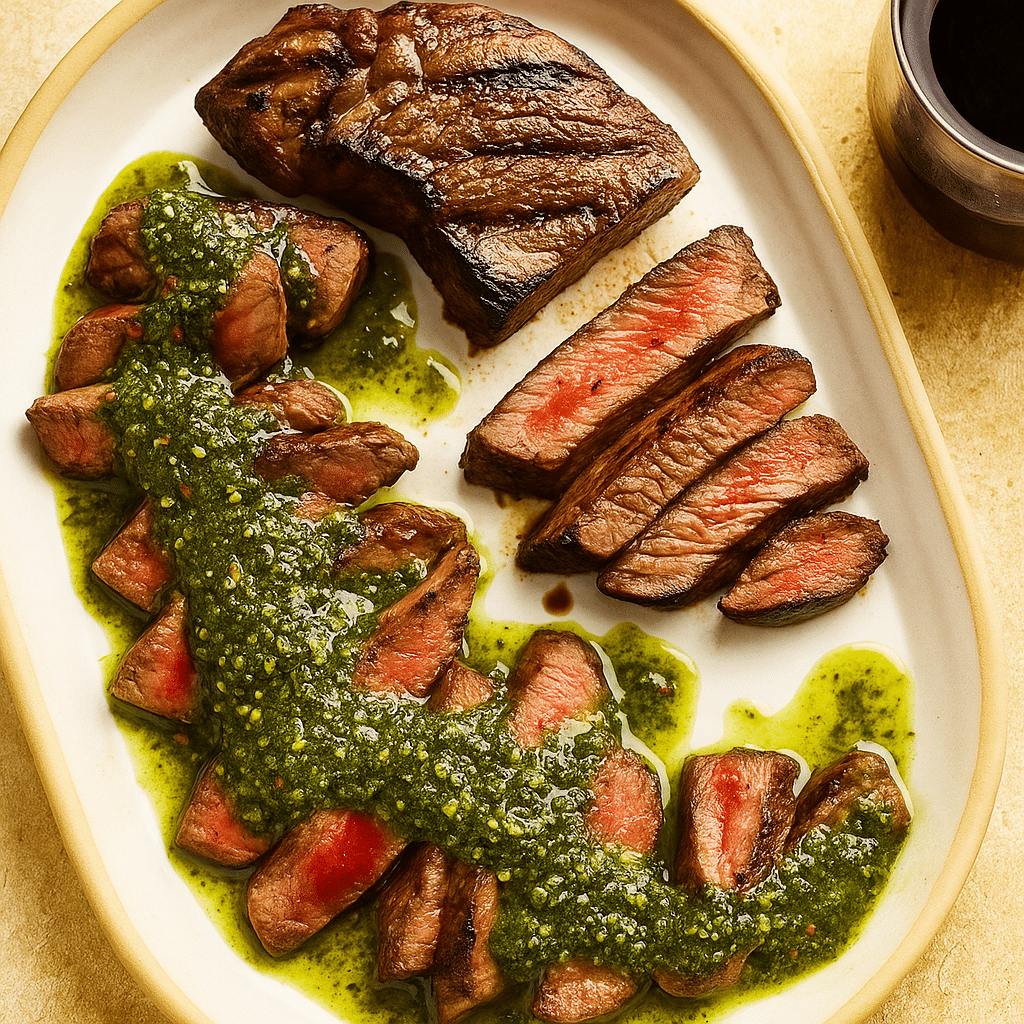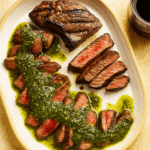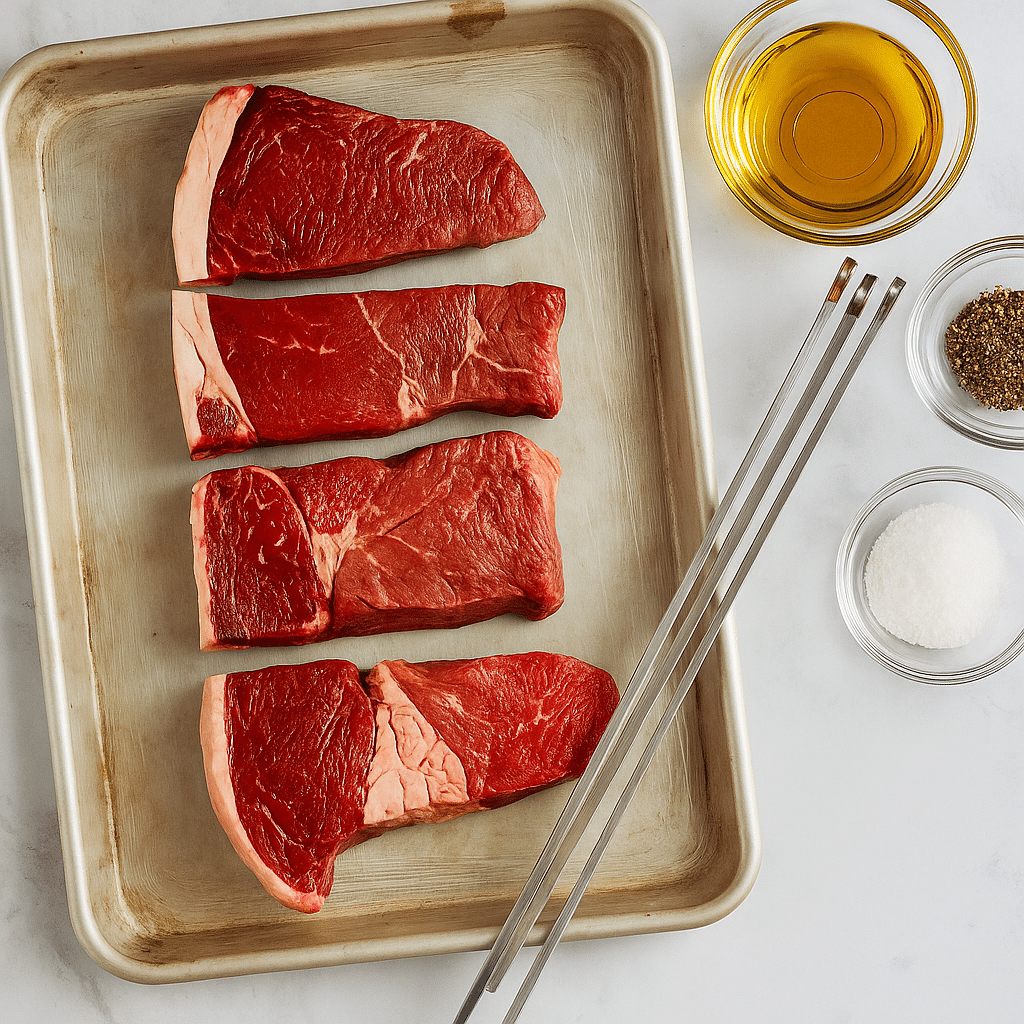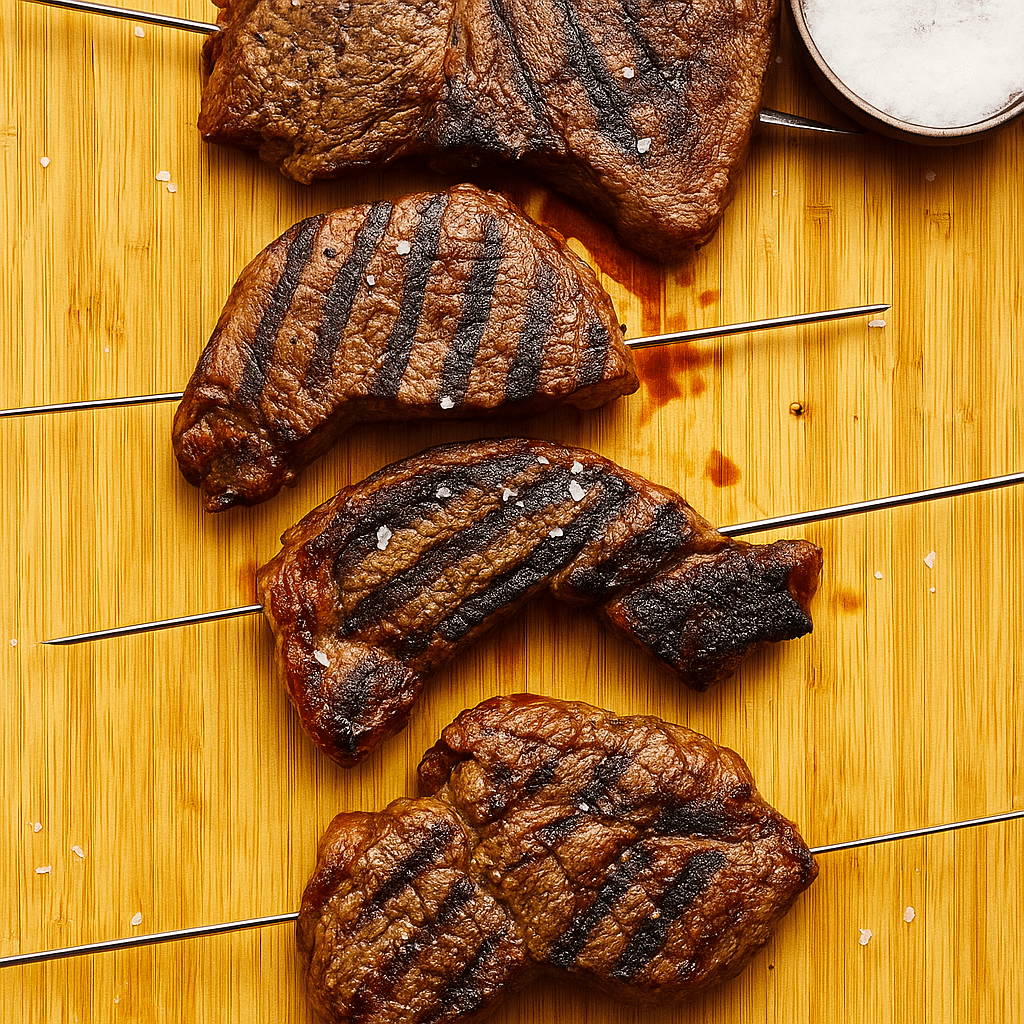Picanha steak has become one of my favorite cuts to grill. My name’s Edward Hale. I was born in Istanbul, raised in Texas, and grew up in a kitchen where beef, fire, and respect for ingredients were the heartbeat of every meal.
Texas taught me how to cook with purpose. My grandma used to turn whatever we had into something unforgettable. That’s where I learned that great food doesn’t need to be complicated, it just needs to be cared for. Over time, I worked in real kitchens, opened my own little restaurant, and mentored cooks who remind me why I started.
Picanha brings all that history together. It’s simple, flavorful, and powerful when done right. You don’t need fancy tricks, just a good steak, a hot grill, and a little patience. Whether you’re new to grilling or just looking for something special, I’m here to walk you through it. This recipe? It’s the kind of food that brings people back to the table. Let’s get started.

Table of Contents
What Is Picanha Steak?
Where It Comes From
Picanha steak comes from the upper rump area and is prized for its generous cap of fat that adds incredible flavor during cooking. In Brazil, it’s the star at churrascarias, grilled on skewers and sliced tableside. That fat cap? It’s what makes the flavor pop. As it cooks, it bastes the meat, keeping it juicy and full of beefy richness.
What It’s Called in the U.S.
In the United States, this cut is often referred to as the sirloin cap, top sirloin cap, or sometimes the rump cap. If your butcher isn’t familiar with “picanha,” just ask for a triangular cut from the rump with the fat still on.
Why It Matters
This cut is all about simple cooking with big payoff. No need for marinades or fancy sauces. Salt, fire, and time do all the work. If you respect the ingredient and the heat, picanha steak delivers every time.
Print
Picanha Steak – Juicy, Flavorful, and Easy to Make
- Total Time: 32 mins
- Yield: 4 1x
Description
Grilled picanha steak is a rich, juicy Brazilian cut cooked with simple seasoning over high heat. This easy recipe brings bold flavor with just salt, fire, and proper technique.
Ingredients
Vegetable oil, for grill
2 lb. sirloin cap, cut into 4 (1 1/2″) steaks
2 1/4 tsp. kosher salt
1 tsp. freshly ground black pepper
Chimichurri, for serving
Instructions
Bring steak to room temperature and slice into thick strips.
Season with salt, and pepper if desired.
Fold into crescent shapes, skewer, and grill over high heat.
Sear the meat on both sides for several minutes, keeping an eye on the internal temperature until it reaches 130°F for ideal doneness.
Let rest 10 minutes before slicing across the grain.
- Prep Time: 10 mins
- Cook Time: 12 minutes
- Category: Proteins
- Cuisine: American
Nutrition
- Serving Size: 4
- Calories: 546
- Sodium: 536 mg
- Fat: 39 g
- Saturated Fat: 15 g
- Trans Fat: 2 g
- Protein: 45 g
- Cholesterol: 141 mg
Is Picanha a Good Cut of Steak?
Flavor That Stands Out
Yes, picanha steak is one of the most flavorful cuts you can put on a grill. What makes it special is the fat cap. That layer of fat slowly melts over the meat while it cooks, giving it a rich taste without needing much else. It’s tender, juicy, and full of bold, beefy character.
I’ve grilled everything from filet to brisket, and this cut always surprises people. It’s not just good, it’s memorable. One bite and you’ll understand why it’s a favorite in Brazil and why more grill lovers in the U.S. are catching on.
Great Steak, Fair Price
Another reason to love picanha steak? It gives you high-end flavor without the ribeye price tag. Compared to pricier cuts, it’s often more affordable, especially if you buy it whole and cut it yourself. Ask your butcher for a sirloin cap and you’ll get more value for your money.
I’ve served this cut in my restaurant and at backyard cookouts. Every time, it gets the same reaction: “Why haven’t I had this before?”
Picanha Steak vs. Ribeye – Which Is Better?
Texture and Taste
Both picanha steak and ribeye bring serious flavor to the table, but they’re different in how they deliver it. Ribeye is loaded with fat marbled throughout the meat, which gives it that soft, buttery texture from edge to edge. It’s rich, and there’s no denying the melt-in-your-mouth feel.
Picanha is leaner through the center but carries a thick fat cap on top. That fat slowly melts over the meat as it grills, basting it naturally. The crust gets crispy, the inside stays juicy, and the contrast in texture is something special. If you like bold beef flavor with just the right amount of richness, picanha delivers.
Cooking Style Makes the Difference
Ribeye is great for pan searing or throwing straight on the grill. It cooks evenly and works well with quick, high heat. Picanha steak, on the other hand, comes alive when you curl it into a crescent, skewer it, and grill it over open flame. That’s the traditional Brazilian way, and it’s not just for show. The shape helps the fat render evenly, keeping every bite tender.
If I’m cooking for myself on a weeknight, a ribeye is easy and dependable. But if I’m feeding friends or firing up the backyard grill, I go with picanha. It’s a crowd-pleaser and a conversation starter. You can’t lose with either, but if you want a little flair with your flavor, picanha is the way to go.
Why Is Picanha So Expensive?
The Social Media Effect
Let’s be honest. Part of the reason picanha steak has become pricier is because it’s gone viral. You’ve probably seen it spinning over flames on TikTok, or getting carved tableside on YouTube with dramatic music in the background. Once people saw how juicy it looked, demand shot up.
That’s what happens when something great flies under the radar for too long. Now, everyone wants it on their grill. More people asking for picanha means higher prices at the butcher. Simple supply and demand.
It’s Not a Common Cut in the U.S.
Another reason for the price is availability. Most U.S. butchers don’t break down beef the same way as in Brazil. That means picanha steak isn’t always separated and sold on its own. You have to ask for it specially, and sometimes that means paying a little more.
But here’s the thing. Even with the rising cost, it still gives you more flavor per dollar than a lot of other premium steaks. It’s worth it. And when you get that first bite with the crispy fat and juicy center, you’ll know why people are willing to pay a bit extra.
How to Make Perfect Picanha Steak at Home
My Go-To Method, Step by Step
When I cook picanha steak at home, I treat it with the same respect I give any great cut of meat. You don’t need tricks or marinades. What you do need is heat, timing, and a light hand. Let’s keep it simple and get it right.
Step 1: Choose a quality cut
Ask for a top sirloin cap with the fat layer intact. That fat is the whole story here. If you’re slicing it yourself, go for thick pieces, around two inches. Always cut across the grain. That’s your first step toward tenderness.
Step 2: Let it breathe
I always leave the meat out for about half an hour before cooking. Meat that’s too cold from the fridge tends to cook unevenly, leaving the center underdone while the outside overcooks. You want it close to room temperature.

Step 3: Salt, and just salt
I don’t mess with heavy seasonings on picanha. Coarse salt is enough. It helps unlock the flavor and allows the natural richness of the beef to take the spotlight. You can grind a little black pepper over it if that’s your thing, but it’s optional.
Step 4: Skewer the steak
Now, take each strip and bend it into a crescent shape. Slide a metal skewer through the middle, keeping the fat cap on the outside. This shape lets the fat drip down and self-baste the steak as it grills. It’s simple, and it works.
Step 5: Hot grill, clean grates
Make sure your grill is hot and the grates are brushed and lightly oiled. I like to start the steak on the hottest zone to build a crust, then move it to indirect heat to finish gently.
Step 6: Cook to temp, not time
You’re aiming for about 130 to 135°F inside for medium-rare. That usually means 4 to 6 minutes per side, but don’t just guess. Use a thermometer if you have one. It’s not cheating, it’s just smart cooking.

Step 7: Rest before slicing
Give the steak 10 minutes off the heat before cutting. Don’t rush this part. Resting keeps those flavorful juices where they belong—inside the meat.

Real Tips from a Working Kitchen
- If the fat cap is too thick in one spot, trim just a little. You want flavor, not chew.
- Use metal skewers, not wood. They hold the heat better and help the steak cook more evenly.
- Don’t press the meat down on the grill. That’s how you lose juices, not gain flavor.
Picanha steak doesn’t ask for much. It just needs a little time, a hot surface, and a cook who’s paying attention. Treat it right and it’ll deliver every single time.
Flavor Variations for Picanha Steak
Building on the Basics
I’ll always stand by salt and fire as the best way to bring out the natural flavor of picanha steak, but there’s nothing wrong with layering in something new once in a while. The trick is to add flavor without covering up the beef. Here are a couple of methods I personally enjoy using.
Smoky Spice Rub
When I’m in the mood for a little more edge, I mix smoked paprika, ground cumin, a touch of brown sugar, and just a hint of chili powder. This creates a subtle crust and adds a smoky-sweet layer that pairs beautifully with the fat cap. I rub it on just before the steak hits the grill. No marinading, no waiting around.
Herb Drizzle After Grilling
Once the steak comes off the grill and rests, I sometimes finish it with a quick herb drizzle. I chop fresh parsley and thyme, stir in lemon zest and olive oil, then spoon that over the sliced meat. It brings a fresh, tangy lift that balances the richness without overpowering the other flavors.
Both of these twists keep the spirit of picanha steak intact. They respect the meat while giving you something a little different on the plate.
Carving and Serving Picanha Steak
Let the Knife Do Its Job
After the grill, after the rest, it’s time to slice. This is the element that ties every component into one delicious, cohesive dish. If you’ve done everything right up to now, don’t lose the magic with a rushed cut.
Start by looking at the grain of the meat. It just means observing how the muscle fibers are aligned so you can slice against the grain for a tender bite. You always want to slice across those fibers, not along them. Cutting against the grain gives you that tender, easy chew. I like to keep my knife at a slight angle and take slow, steady strokes. Nothing fancy. Just confident, clean cuts.
If you cooked your picanha steak on a skewer, you can serve it straight from the metal. That’s how they do it in Brazilian steakhouses. If you removed it from the skewer already, place it flat on a board and slice it just like any other steak, making sure to go across the grain.
Keep It Simple on the Plate
This cut doesn’t need dressing up. It brings enough flavor on its own. I usually serve it with something fresh and balanced. Grilled veggies, a tomato salad with olive oil, or even a bit of citrus-dressed greens.
If you like a sauce, go for something clean. A spoonful of herb oil or a light chimichurri adds contrast without taking over the plate. The goal isn’t to hide the steak. It’s to let it shine.
At the end of the day, picanha steak is about bold flavor and honest cooking. Carve it with care, serve it with respect, and you’ll have a dish that speaks for itself.
For more recipes, follow me on Pinterest or Instagram
Storing and Reheating Picanha Steak
What to Do When You Have Leftovers
When picanha steak makes it to the next day, that usually means you cooked more than you needed, and that’s never a bad thing. The trick is knowing how to keep it tasting great.
After cooking, let the steak cool down at room temperature. You don’t want to trap steam in a container, because that just turns your crust soft. Once it’s cooled, place it in a shallow, sealed container. If it’s already sliced, lay the pieces flat with a bit of space between each. That helps keep the texture from going mushy.
In my own kitchen, I don’t hold it longer than two days. Past that, it starts to lose the richness and that deep grilled character.
How I Bring It Back
The goal isn’t to just make it hot. It’s to warm it gently, so you keep as much of that original flavor as possible.
If I’m at home, I’ll take a cast iron pan, warm it up on low heat, and add just a teaspoon of water or broth to keep some moisture in the pan. Then I lay the slices in, cover them, and give it a few minutes until everything is just warmed through. That low, steady heat brings the steak back to life without drying it out.
Another method I use is the oven. I wrap the steak in foil, put it in a small baking dish, and let it warm at 275 degrees Fahrenheit for about 10 minutes. No flames, no high heat, just a slow reheat that respects the work you put in the day before.
One last tip: don’t re-sear it. That second blast of high heat takes away more than it gives. The flavor is already in there. You just need to wake it up.
Conclusion
If there’s one thing I’ve learned from years at the grill and behind the line, it’s this, great food doesn’t have to be complicated. Picanha steak proves that. With the right cut, a bit of salt, and a hot grill, you can create something that feels like a celebration. This isn’t a steak that needs a lot of extras. It just needs your attention and a little respect for the process.
Whether you’re firing up the grill for the first time or you’ve been cooking outdoors for years, this cut brings people together. That fat cap, that crust, that deep beefy flavor, it’s the kind of thing that turns dinner into a memory.
I hope you try it for yourself. Make it your own. Cook it for friends, share it at the table, and enjoy the process. That’s what real food is about. And when you do, you’ll understand why I keep coming back to picanha steak, again and again.

FAQa About Picanha Steak
Is picanha a good cut of steak?
Yes, it absolutely is. In fact, picanha steak is one of my personal favorites. It comes with a nice fat cap that keeps the meat juicy during cooking, and when you get it on a hot grill, the flavor is unbeatable. It’s not overly marbled like some other cuts, but that outer fat does all the work if you cook it right. It’s the kind of cut that gives you a satisfying chew and deep beef flavor in every bite.
What is picanha steak called in the U.S.?
Most butcher shops in the U.S. don’t use the word “picanha.” Instead, it’s usually labeled as top sirloin cap, rump cap, or sirloin culotte. The key thing to look for is that triangle shape and, most importantly, the fat cap. If you’re not sure, just ask the butcher for the top section of the sirloin with the fat still on. A good butcher will know what you’re after.
What is better, ribeye or picanha?
It comes down to what kind of steak you enjoy. Ribeye is rich with fat running through the whole cut, giving it a soft, buttery feel. Picanha steak, on the other hand, has leaner meat and relies on its outer fat for moisture and flavor. I go with ribeye when I want something heavy and indulgent. I turn to picanha when I want that strong beef taste, a little bite, and a crisp edge from the grill. They’re both excellent, just different.
Why is picanha so expensive?
The price has gone up because more people are catching on to how good it is. In most American meat processing, picanha isn’t always separated out as its own cut, so it takes a little extra work to get. Add to that the buzz from social media, where you see it sizzling on skewers or carved at the table, and demand jumps fast. Still, for the eating experience it gives, I’d say it’s worth every penny.





